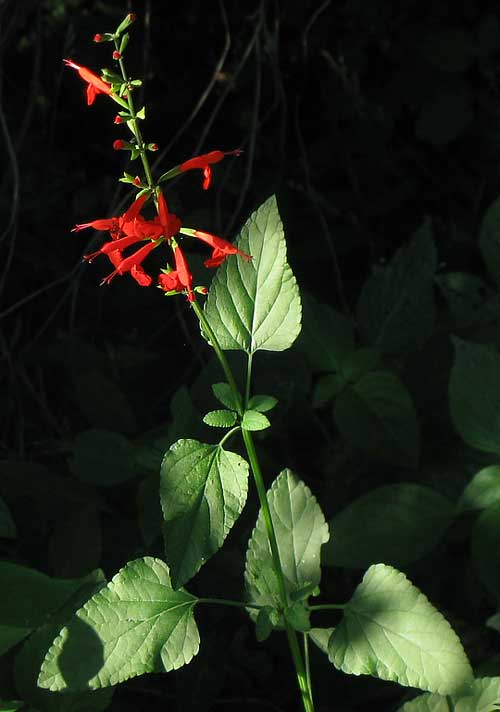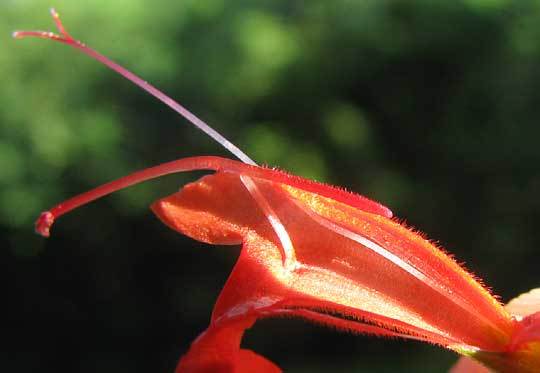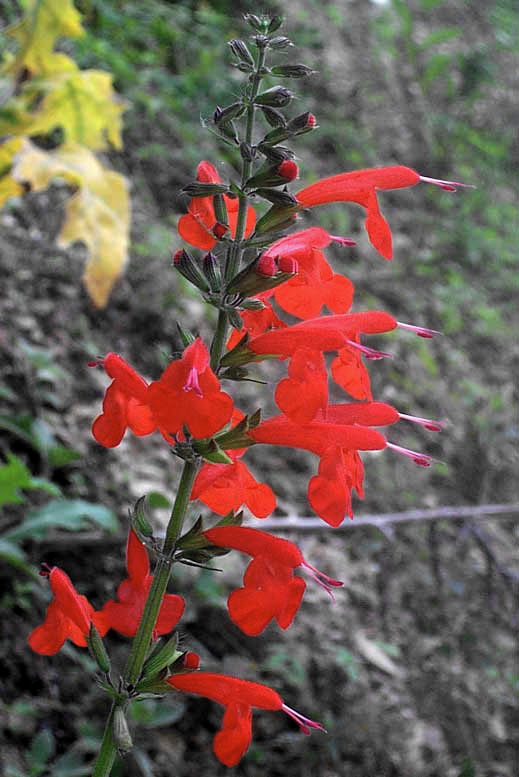Excerpts from Jim Conrad's
Naturalist Newsletter
from the January 3, 2010 Newsletter issued from Hacienda Chichen Resort beside Chichén Itzá Ruins, central Yucatán, MÉXICO
SCARLET SAGE'S AMAZING STAMENS
One of the most conspicuous wildflowers growing weedily along roads and at woods edges these days is the brilliantly crimson-blossomed Scarlet Sage, SALVIA COCCINEA, found throughout tropical America north into the southern US, from coast to coast. The Scarlet Sage bought by gardeners in the spring is a different species, a horticulturally modified plant based on a wild Brazilian Scarlet Sage, Salvia splendens. The sage used as a seasoning is Salvia officinalis. All three of these species are real sages, meaning that they're members of the genus Salvia, in the Mint Family. You can see Yucatan's Scarlet Sage below:

You know you have a sage -- a Salvia -- if the flowers bear only two pollen-producing stamens, the calyx (green part below the colored corolla) is topped by only two broad, liplike teeth (is "bilabiate"), the corolla's upper lip is entire or split in two, not 4-lobed, and the plant's leaves are deciduous. In all the sage blossoms I've seen, the flower's two stamens do something extraordinary. I've removed one side of a Salvia's corolla so you can see what I'm talking about below:

The long, slender, violet-tinged item forked at its tip is the style, which is the "neck" connecting the ovary down in the blossom with the stigmas up at the Y, where pollen germinates. So that' a female part.
With regard to the male part, the stamens of most kinds of flower are matchstick-shaped, the "stick" being the filament and the match head being the anther. The anther consists of two baglike parts, or "cells," which split open to release pollen. In the picture, the deep red, slender, slightly curved, horizontal item is a much modified anther. The two pollen-producing cells lie at opposite ends of the structure, most of the structure between them being "connective" doing no more than connecting the cells. The cell outside the corolla tube produces pollen but the cell inside the tube is sterile. The pale, slender thing attaching to the anther-structure's center is a more or less normal filament, its base attached to the corolla's side wall. Why do Salvia flowers go to such trouble producing such outlandish stamens?
First notice that the forked stigmas project beyond the other parts. Therefore, any hummingbird arriving at the flower bearing on his forehead pollen from another blossom will first touch that stigma with his forehead, thus pollinating the flower.
Now imagine the hummingbird's beak continuing to enter the corolla tube. As it enters it encounters two red, fingerlike things descending from the ceiling -- the inner arms of the two anthers. The arms yield, however, so the beak keeps going until it reaches the nectar, the anthers' inner arms being forced upward until they're flush with the ceiling.
As those inner arms ascend, the whole anther structure swivels at its attachment with the filament, and the outer arms -- the arms bearing pollen-producing anther cells -- arc downward... daubing the hummingbird's forehead with pollen. So that's how pollen from another Salvia flower got on the hummingbird's forehead in the first place.
If you grow sage, or Salvias, you can see this on your own flowers. It's amazing, but it's something happening around us all the time.
from the August 32, 2007 Newsletter issued from Sierra Gorda Biosphere Reserve, QUERÉTARO, MÉXICO
SCARLET SAGE
One of the most eye-catching flowering herbs here grows among limestone outcrops along the reservoir road. It's attention-getting because of its flowers, which are so red that on a dark, overcast morning it's hard for the eyes to focus on them. You can see such blossoms below:

This is SALVIA COCCINEA, found throughout tropical America north into the southern US. Our wild-growing Scarlet Sage is a real sage because it belongs to the genus Salvia. Salvia is a vast genus with over 900 species and most of them are either bright red or bright blue.